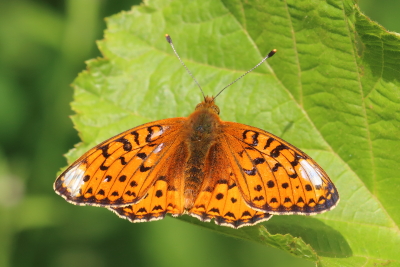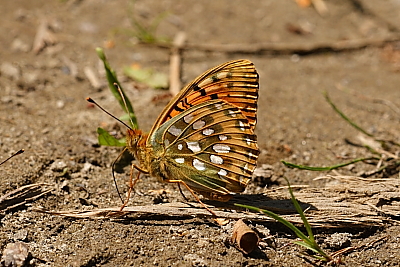













Dark Green Fritillary (Argynnis aglaja)
2024 photographs highlighted in yellow. Click on any photograph to go to an enlarged picture, or simply scroll down the page.
|
Reasonably common across France, and commonly found at altitude, often in good numbers. The upperside can be differentiated from the High Brown Fritillary (A. adippe) by the indicators described on the adippe page.
The upperside can be differentiated from
|
In some textbooks aglaja is spelt aglaia.
In 2019 this species was reclassified as Speyeria aglaja. I'll give it a few years before changing the web page (and all the occurrences and links associated) as it is entirely possible that the taxonomists will change it again. Also Argynnis aglaja is in common use and often used in web searches, etc. |
| ref | sex |
observations |
alt. m |
| 18040 | M |
a male puddling, the forewings held back in a pose that seems normal for aglaja when puddling. The orange seems rather dull compared to others on this page, but it is not clear whether this is natural or just the result of wear. |
1120 |
| 26482 | M | a very fresh male. | 1400 |
| 44156 | M | a male puddling, almost completely fresh and a beautiful deep orange colour, even with orange-ish fringes. | 1600 |
| 49627 | M | a very fresh male, with fringes completely intact. | 1930 |
| 7827 | M |
a male, based on the lighter markings, the albeit quite light sex brands on v2 and v3, and the just-visible body. Not 100% certain, though. |
2100 |
| 53011 | M | a male with an area of scales missing from each forewing tip. I don't know the reason for this but it is unlikely to be damage incurred in flight. I suspect it is because the scales in these regions did not detach from the chrysalis on emergence. It looks too "clean" to be anything else. The same thing is apparent on 44451 on the niobe page. | 1380 |
| 44579 | F | a female, slightly unusual in that the upf post-discal spots are rather heavy. | 1550 |
| 27084 | F | a female, slightly suffused. | 2020 |
| 22597 | F |
a female as indicated by the heavier markings and confirmed by the absence of sex brands. |
1120 |
| 05_19-07 | F |
an old photograph of a very heavily marked and suffused female. It actually looked like this in real life. I have seen females like this on a few subsequent occasions. |
|
| 18301 | M | a male puddling. | 1120 |
| 33160 | M | a male, probably immediately after emergence. It is unusual in that much of the area surrounding the silver marks is brown rather than green, although it is rather greener in the lower regions of the hindwing. | 1100 |
| 30842 | M | a male puddling. | 1240 |
| 48356 | M | a male, apparently freshly emerged but with slight damage to the wing-tip. | 1820 |
26482_male_Alpes-Maritimes_07Jul11
44156_male_Hautes-Pyrénées_11Jul17
7827_male?_Hautes-Alpes_3Jul07
53011_male_Hautes-Alpes_13Jul24
44579_female_Alpes-Maritimes_18Jul17
27084_female_Hautes-Alpes_14Jul11
33160_male_Alpes-de-Haute-Provence_30Jun13
48356_male_Pyrénées-Orientales_12Jul21